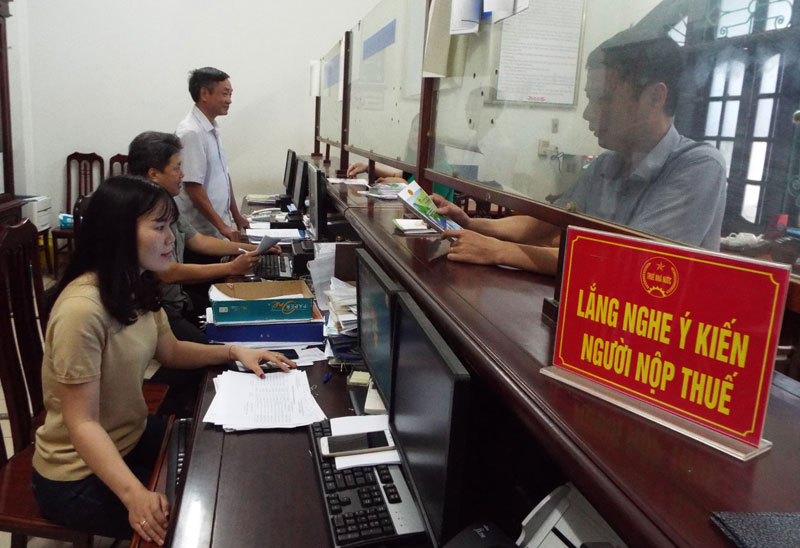
(HBO) – By July 31, 2017, total tax arrears in the northern mountainous province of Hoa Binh had stood at nearly 304.2 billion VND, of which more than 61.7 billion VND was overdue, down 5.7 billion VND as compared with the figure at the end of 2016. Of the total, bad debts accounted for over 111.3 billion VND, down 2 percent from the figure at the end of 2016) and recoverable debts were 193.9 billion VND, accounting for 7.4 percent of the estimates.
Hoa Binh city’s Taxation Sub-department well
reviews and manages income sources, creating favourable conditions for taxpayers
to fulfill their obligations to contribute to the State budget.
The provincial Department of Taxation has publicised a list of 38 businesses
which had owed more than 142.3 billion VND of tax by July 31, 2017.
In implementing the guidelines of the General Department of Taxation regarding
measures to collect tax debts in 2017, the provincial Department of Taxation
has instructed its city and district chapters and the debt management office to
base on the devised plan in order to instruct tax debt collection.
Drastic
measures will be taken to collect recoverable debts, striving to reduce both number
of debtors and debt amount by December 31, 2017, the department said, noting
that the debts should not exceed 5 percent of the State budget collection in
2017.
In July 2017, the provincial Department of Taxation made 1,106 phone calls and
sent 7,739 messages to businesses to inform them the amount of tax debts and
fines they have to pay.
The
department also held working sessions with nine businesses which failed to pay
tax but have financial difficulties. They were asked to commit to paying the
debts.
At
the same time, the department sent 242 documents to relevant credit
institutions and businesses in order to verify information and employ coercive
measures.
It issued 59 decisions asking for debt payments by taking money, blocking their
bank accounts, informing valueless invoices, coercing the third party and requesting
business licence withdrawal.
The names of businesses which still owed tax have also been publicised on the
sector’s websites and mass media.
To businesses which owed tax debts as they have yet to receive capital from the
State budget, the department will continue to review, instruct and issue nine
notices on allowing "no calculation of late payment” (in line with Clause 10, Article
2, Circular No. 26/2015/TT-BTC dated February 27, 2015, and Circular No.
06/2017/TT-BTC dated January 20, 2017 issued by the Ministry of Finance).
Along with measures to improve responsibility and capacity of tax officers, the
department is reviewing, classifying debts, synthesizing tax debts and
analysing reasons of each debtor./.
Dao Village’s honey – a product certified with a 3-star OCOP (One Commune One Product) rating by Thong Nhat Agricultural Cooperative in Dao Village (Hoa Binh City) – is highly regarded by consumers for its quality, richness, and variety in packaging. The distinctively sweet taste of Dao Village’s honey leaves a lasting impression on anyone who has tried it.
In alignment with Project No. 07-DA/TU, issued by the Hoa Binh provincial Party Committee on November 1, 2021, Lac Thuy district has actively promoted investment and supported the sustainable development of its industrial and handicraft sectors during the 2021–2025 period. Alongside this, the district has remained committed to preserving and revitalising traditional craft villages.
Located in the northern part of Lac Thuy district, with a temperate climate and fertile soil, Phu Thanh commune has great potential and advantages in growing tea. The long-standing experience, combined with strict adherence to organic farming practices in the tea gardens, ensures that the dried tea products from Phu Thanh and Lac Thuy as a whole are sold out immediately upon production, providing a stable and prosperous life for the local people.
Amid efforts to streamline the administrative apparatus, Hoa Binh province has intensified measures to address challenges in land clearance, resettlement support, and infrastructure investment, aiming to speed up the progress of key projects.
Hoa Binh province has posted an unprecedented economic growth rate of 12.76% in the first quarter of 2025, marking its highest quarterly performance to date and positioning it as the second fastest-growing locality in the country, trailing only Bac Giang province.
Under current regulations, products in the One Commune – One Product (OCOP) programme that are rated three stars or higher must undergo re-evaluation every three months. However, in reality, some of these products fail to consistently meet the required standards, raising concerns about the sustainability of their OCOP certification. This underscores the urgent need for producers to enhance product quality and gradually develop their OCOP products into strong, marketable brands.



